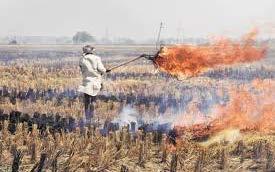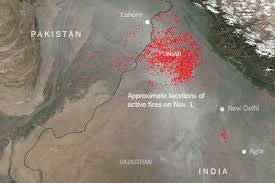
7 minute read
Consideration on Stubble Burning and suggested way ahead
Delhi NCR faces the haze of Air Pollution every year and it gets unbearable and schools are to be shut for prolonged periods while health conditions deteriorate and in cases of lung ailments; those are irreparable.
Problem Statement Stubble burning in Delhi NCR has been a bane to living in the Area with Air Pollution being at ‘Emergency Levels’.
Key Analysis Pointers 1. Farmers are inclined and have their backs against the wall, as they have to sow for next season and they do not have any bandwidth to aggregate and store biomass, especially when there is no offtake available. 2. Not enough industry has been developed around use of biomass and quantum of biomass available in the Country is huge. 3. Biomass-based Supply Chain is not bankable and has not been recognised as an Industry. MSME etc need to recognise that first. 4. Financial institutions do not accept this Biomass-based industry at the moment; while some actions are pending implementation. 5. While heating, cooling and steam have been laid down as Renewable Energy in July 2019, not

much traction in projects of PSUs etc has taken place and private industry has not stepped in, in terms of bigger players.
AIM: To aggregate One Million Metric Tonnes of agri-waste from fields, as a Pilot Project, in Punjab, with Central & State Govt assistance, by building a Win-Win Solution in the People Public Private Partnership Ethos; termed PPPP Model 2020
Recommended Solution Framework Model A People Public Private Partnership (PPPP) Model could be evolved to foster mitigation of the stubble burning and use of biomass in Bio-Energy Projects. The People would be farmers and all associated in the Ecosystem. First avenue for creating such a model could be for Bio-CNG projects and it’s monitoring being under aegis of the PMO and these could start to be implemented for next harvest Season. Second avenue is the Bio-Ethanol (2G) Sector with projects lined up at Bhatinda, Punjab of HPCL & at Barghar, Orrisa of BPCL etc; by year 2022 or, so. The People-Aggregation to PSU-Offtake Model; with entire Ecosystem being on Open-Book Business Format; with Public and Private Sector chipping in, will be a Game Changer and it will energise the Biomass-based Bio-Energy Sector in India. This Model can be replicated for all small, medium and large industrial applications later in India. Apart from the initial payment to farmers for the agricultural residues supplied by them, part of the profits accrued through sales of the Bio-fuel or, final commodity made from that agricultural waste, could also be ploughed back to the farmers. This will make this PPPP Model more robust and sustainable in the future; as it will bring about greater Rural Development and enhance the achievement of Sustainable Development Goals (SDGs). India has a potential to lead the Biomass-based Bio-Energy Sector in this format while it’s economy will start to blossom like never before with shrinking reliance on crude and enhancement of entrepreneurship, skill development, manufacturing and self-reliance being a major take away.
Stakeholders and their Solicited Contributions a) Farmers Aggregate themselves and through private players, the biomass required; based on a realistic assessment done by a Private Consultant or Govt Institution. b) State Govt Provisioning of land, water and electricity etc for the Pilot Project. c) Central Govt Release of funds, policy guidelines, facilitate FDI, facilitate imports of machines and technology and monitoring through a Committee, consisting of independent person, Govt appointee and industry. d) Biomass Supply Chain Management Company Roll Out the entire Biomass Supply Chain including Awareness Campaigns, Aggregations, Storage, Logistic Chain, Supply to Project.

e) O&M Company The PSU or, private company which will do O&M for the Project and ensure 96% availability of the production. f) Sales Company The PSU or, private company which will conduct and monitor sales of the produce. This off-taker has to be finalized and guaranteed by the Govt. g) IREDA & / or, Other Govt Financial Institutions / NBFCs Post drawing down of funds from Govt or, UN bodies or, Impact Funds etc, make Debt Loans and Working Capital available to private companies and PSUs involved at less than 4% interest. h) Insurance Company Public or, private Insurance Company would have to take on the mandate of insurances for various aspects of this Project. i) Finance Ministry Make available funds for the Project and that may include allocation of some quantum of CSR Funds. In future, CSR could contribute from it upto 0.25 to 0.5% towards Biomass-based Bio-Energy Sector and this might give a boost to this Sector in India. Loans at 2 to 4 percent or, less, to farmers & private sector involved in Supply Chain Management (SCM) of the agri-residue. Cover Biomass-based Bio-Energy Sector in Priority Sector Lending with larger cap. j) ISRO / NTRO Give technological inputs on weather, soil etc to the concerned stakeholders, at the behest of the Govt of India. Identification of air streams is important. k) FCI / NABARD etc Provide access to available storage sheds & build more and also cater to construction of weather-agnostic Silos and Under Ground storage facilities etc. l) MSME Establish the Sector and this Pilot Project under MSME with benefits. m) MNRE, Ministry of Power, Ministry of Agriculture, Ministry of Petroleum etc Enable policies implementation for biomass-based Bio-Energy Projects in India and ensure their applicability much prior to the Pilot Project being envisaged. n) Niti Aayog To be the Central Coordination Agency and one-point contact for all stakeholders for the PMO, to enable smoother Decision Making. o) PMO Lead this Pilot Project till it’s implementation by 2020-21 and analysis of gains accrued and then further direct the Policy Making in the Biomass-based Bio-Energy Sector in India.
Benefits Envisaged (a) Creation of an Ecosystem, based on type of Bio-Fuel and end-use, to fully support Biomass-based Bio-Energy Sector in India and allow influx of more Projects of both PSUs and Private Sector and foreign players. (b) Evolution of a truly beneficial PPP Model in India. (c) Enhance Rural Development with double income for farmers, financial inclusion, more jobs etc. It is the best way to establish ‘Ann Data to Oorja Data’ for the farmer community. (d) Lead the Climate Change initiative and work towards SDGs agreed upon during the Paris Agreement, through the Biomass-based Bio-Energy Sector by getting Green Fuels and reducing dependency on fossil fuels and also, reducing carbon, SOX & NOX emissions. (e) Greatly improve the health conditions of Indians and bring down the medical bills and expenditure; which has been noted to be 30 Billion by a US-based study group. (f) Ensure sustainable Renewable Energy through biomass; a commodity which is aplenty in India and directly related to welfare of the farmers. (g) It will rope in more and more ex-servicemen in this Sector and that will ensure the dependability on the Model and lead to good deliverance too. (h) It will set an example of the huge benefits of low-cost funding in the rural sector and Biomass-based Bio-Energy Sector and that will further strengthen the sustainability aspects in this Sector. (j) Our expenditure on fossil fuels will reduce substantially in the future and this will lead to better energy transition in India where motor vehicles could start with ethanol and move towards EV and Solar-powered vehicles and Aviation could graduated to Drop In or, Bio-fuels from biomass and so forth and so on.
(k) India being a huge market for bio-fuels, will attract tremendous FDI and establishment of Projects and manufacturing units of varied kinds in India and that will give impetus to Make In India, more employment, better market share of production of bio-fuels in the world, growth boost to economy etc.
Conclusion India is at a cusp of a ‘Green Energy Revolution’ and Biomass-based Bio-Energy Sector is set to lead the way. The Govt of India and it’s citizens and especially the farmers have an opportunity to shape this future, as a Win-Win for all stakeholders and participation of more from the industry including manufacturing, will give the due impetus to the Govt-led Drive to bring the changes in ensuring a Cleaner and Healthier India and Planet Earth. It should be a ‘Collective Endeavour’ of all of us to ‘See through the Haze’ and chart out a sustainable course for a better future for Generation-Next; as this Planet must live longer than what today we think it would. The onus as Citizens and Govt is on us; as me make the choices and the margin of error in that is zilch. Let’s take it on ‘Together’!
IF THERE IS A WILL, THEN, THERE IS A HIGHWAY IT HAS TO BE A ‘COLLECTIVE TOIL’ WITH A ‘TOPDOWN IMPLEMENTATION’ AND ‘BOTTOM-UP EXECUTION’ INTEGRATED APPROACH TO ACHIEVE THIS HUMBLE DREAM UNDER PMOLED “AAN TO OORJA” SCHEME

Colonel Rohit Dev (Retd.)
Chief Operating Officer
PRESPL



